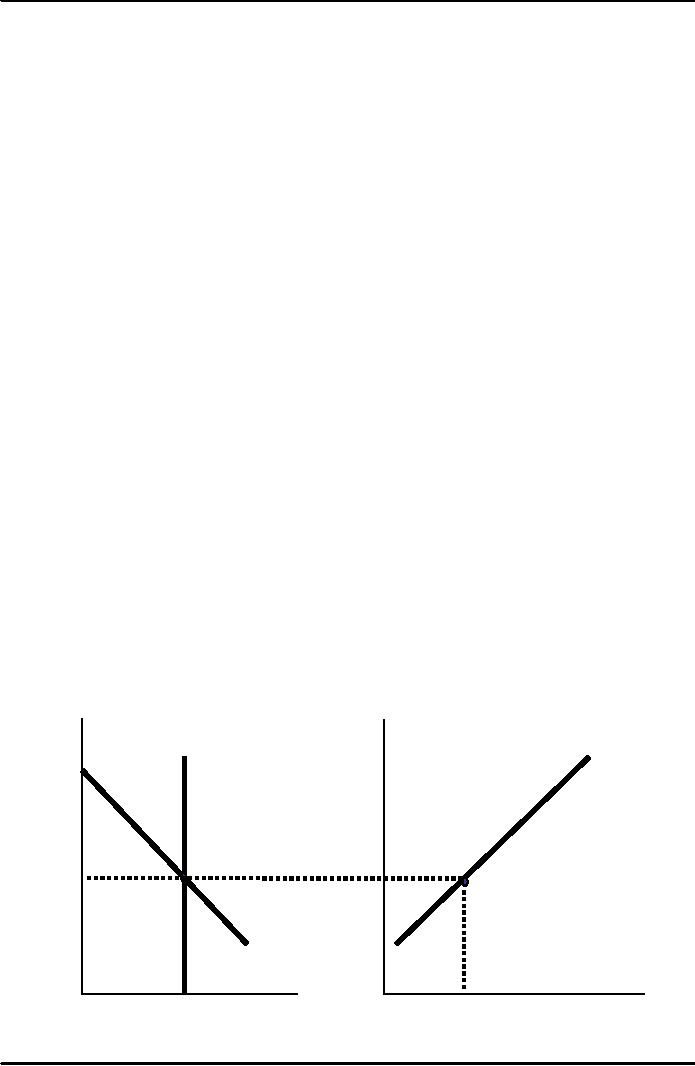 |
INVESTMENT (Continued…):Financing Constraints, Residential Investment |
| << INVESTMENT (Continued…):The Determinants of Investment |
| INVESTMENT (Continued…):Inventories and the Real Interest Rate >> |

Macroeconomics
ECO 403
VU
LESSON
42
INVESTMENT
(Continued...)
The
Stock Market and Tobin's
q
·
The
term stock refers to the
shares in the ownership of
corporations
·
Stock
market is the market in
which these shares are
traded.
·
The
Nobel-Prize-winning economist James
Tobin proposed that firms
base their
investment
decisions on the following
ratio, which is now called
Tobin's
q:
q=
Market
Value of Installed
Capital
Replacement
Cost of Installed
Capital
The
numerator of Tobin's q is the
value of the economy's
capital as determined by
the
·
stock
market. The denominator is
the price of capital as if it
were purchased today.
Tobin
conveyed that net investment
should depend on whether q is
greater or less than
·
1.
·
If q
>1, then firms can
raise the value of their
stock by increasing
capital,
·
if q <
1, the stock market values
capital at less than its
replacement cost and
thus,
firms will not replace
their capital stock as it
wears out.
Tobin's
q and neo-classical model
are closely related, since
Tobin's q measures
the
·
expected
future profitability as well as
the current
profitability.
If
the MPK exceeds cost of
capital, the firms are
earning profits on their
installed
·
capital,
making rental firms
desirable to own, raising
market value of stocks of
such
firms,
implying a high value of
q
The
Stock market as an Economic
Indicator
·
Although
the volatility of stock
market can give false
signals about the future of
economy,
yet
one should not ignore
the link between the
two.
·
Changes
in stock market often
reflect changes in GDP. whenever
stock market
experiences
a
substantial decline, we should be
ready for an upcoming
recession.
·
Why
do stock prices and economic
activity tend to fluctuate
together?
·
Tobin's
q and AD-AS Model
Suppose there
occurs a fall in stock
prices. Since replacement
cost of capital is
stable,
this
will result in a fall in
Tobin's q, reflecting investors'
pessimism about the current
or
future
profitability of capital.
·
Some
Additional Reasons
A fall in stock
prices makes people poorer,
depressing their spending,
resulting in
reduced
aggregate demand
Fall in stock
prices reflect bad news
about technological progress
and economic growth,
resulting
in slow expansion of natural
rate of output.
Financing
Constraints
·
When
a firm wants to invest in
new capital, e.g. by
building a new factory, it
raises the funds
in
financial markets by
Obtaining
loans from banks
Selling bonds
to public
Selling shares
in future profits on stock
market
·
Neo
classical model assumes that
if a firm is willing to pay
cost of capital, financial
markets
will
make the funds
available.
195

Macroeconomics
ECO 403
VU
·
But
sometimes firms face
Financing constraints, limiting
the amount of funds they
can raise
from
financial market.
·
So
the amount a firm can
spend on new capital goods
is limited to the amount it is
currently
earning.
·
For
example, a recession reduces
employment, rental price of
capital and profits. If the
firm
expects
the recession to be short
lived, it will continue
investing for long term
profitability,
thus
having a small effect on
Tobin's q.
·
So
the firm that can
raise funds in financial
markets will face a small
effect of recession on
the
investment.
·
While
incase of firms facing
constraints, the fall in
current profits restrict the
spending on
new
capital goods and may
prevent such firms from
making profitable
investment.
Residential
Investment
We
will now consider the
determinants of residential investment by
looking at a simple
model
of
the housing market.
Residential investment includes
the purchase of new housing
both by
people
who plan to live in it
themselves and by landlords
who plan to rent it to
others.
To
keep things simple, we shall
assume that all housing is
owner-occupied.
There
are two parts to the
model:
1)
The market for the
existing stock of houses
determines the equilibrium
housing price
2)
The housing price determines
the flow of residential
investment.
·
The
relative price of housing
adjusts to equilibrate supply
and demand for the
existing stock
of
housing capital.
·
Construction
firms buy materials and
hire labor to build the
houses and then sell
them at
market
price.
·
Their
costs depend on the overall
price level P while their
revenue depends on the price
of
houses
PH.
·
The
Higher the PH,
the greater incentive to
build house.
Market
for Housing
Supply
of New Housing
PH/P
Relative
S
Price
of
housing
PH/P
D
Stock
of housing capital, KH
Flow
of residential investment, IH
196

Macroeconomics
ECO 403
VU
·
This
model of residential investment is
much similar to q theory of
business fixed
investment,
which states that business
fixed investment depends on
the market price of
installed
capital relative to its
replacement cost, which in
turn depends on expected
profits
from
owning installed
capital
·
The
residential investment depends on
the relative price of
housing, which in turn
depends
on
demand for housing,
depending on the imputed
rent that individuals expect
to receive
from
their housing
197
Table of Contents:
- INTRODUCTION:COURSE DESCRIPTION, TEN PRINCIPLES OF ECONOMICS
- PRINCIPLE OF MACROECONOMICS:People Face Tradeoffs
- IMPORTANCE OF MACROECONOMICS:Interest rates and rental payments
- THE DATA OF MACROECONOMICS:Rules for computing GDP
- THE DATA OF MACROECONOMICS (Continued…):Components of Expenditures
- THE DATA OF MACROECONOMICS (Continued…):How to construct the CPI
- NATIONAL INCOME: WHERE IT COMES FROM AND WHERE IT GOES
- NATIONAL INCOME: WHERE IT COMES FROM AND WHERE IT GOES (Continued…)
- NATIONAL INCOME: WHERE IT COMES FROM AND WHERE IT GOES (Continued…)
- NATIONAL INCOME: WHERE IT COMES FROM AND WHERE IT GOES (Continued…)
- MONEY AND INFLATION:The Quantity Equation, Inflation and interest rates
- MONEY AND INFLATION (Continued…):Money demand and the nominal interest rate
- MONEY AND INFLATION (Continued…):Costs of expected inflation:
- MONEY AND INFLATION (Continued…):The Classical Dichotomy
- OPEN ECONOMY:Three experiments, The nominal exchange rate
- OPEN ECONOMY (Continued…):The Determinants of the Nominal Exchange Rate
- OPEN ECONOMY (Continued…):A first model of the natural rate
- ISSUES IN UNEMPLOYMENT:Public Policy and Job Search
- ECONOMIC GROWTH:THE SOLOW MODEL, Saving and investment
- ECONOMIC GROWTH (Continued…):The Steady State
- ECONOMIC GROWTH (Continued…):The Golden Rule Capital Stock
- ECONOMIC GROWTH (Continued…):The Golden Rule, Policies to promote growth
- ECONOMIC GROWTH (Continued…):Possible problems with industrial policy
- AGGREGATE DEMAND AND AGGREGATE SUPPLY:When prices are sticky
- AGGREGATE DEMAND AND AGGREGATE SUPPLY (Continued…):
- AGGREGATE DEMAND AND AGGREGATE SUPPLY (Continued…):
- AGGREGATE DEMAND AND AGGREGATE SUPPLY (Continued…)
- AGGREGATE DEMAND AND AGGREGATE SUPPLY (Continued…)
- AGGREGATE DEMAND AND AGGREGATE SUPPLY (Continued…)
- AGGREGATE DEMAND IN THE OPEN ECONOMY:Lessons about fiscal policy
- AGGREGATE DEMAND IN THE OPEN ECONOMY(Continued…):Fixed exchange rates
- AGGREGATE DEMAND IN THE OPEN ECONOMY (Continued…):Why income might not rise
- AGGREGATE SUPPLY:The sticky-price model
- AGGREGATE SUPPLY (Continued…):Deriving the Phillips Curve from SRAS
- GOVERNMENT DEBT:Permanent Debt, Floating Debt, Unfunded Debts
- GOVERNMENT DEBT (Continued…):Starting with too little capital,
- CONSUMPTION:Secular Stagnation and Simon Kuznets
- CONSUMPTION (Continued…):Consumer Preferences, Constraints on Borrowings
- CONSUMPTION (Continued…):The Life-cycle Consumption Function
- INVESTMENT:The Rental Price of Capital, The Cost of Capital
- INVESTMENT (Continued…):The Determinants of Investment
- INVESTMENT (Continued…):Financing Constraints, Residential Investment
- INVESTMENT (Continued…):Inventories and the Real Interest Rate
- MONEY:Money Supply, Fractional Reserve Banking,
- MONEY (Continued…):Three Instruments of Money Supply, Money Demand